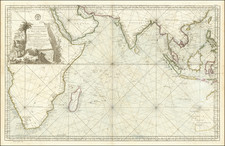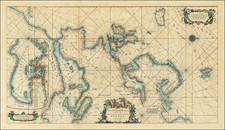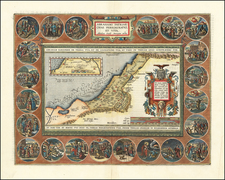Rare Czech language edition of Bunting's Itinerarium Saccrae Scripturae first published in 1581. The map shows the Eastern Mediterreanean, including Sicily, Malta, Cyprus, Rome, the Holy Land, Alexandria, the southern Black Sea, Constantinopel Greece, Asia Minor, Armenia, etc. Sea Monster shown in the Mediterranean. This example includes an unusually dark rich impression of the map and Czech text on the verso. No appearance of the Czech edition of this map has appeared in a dealer catalogue in the past 25 years.
Henrich Bunting was a Protestant theologian and teacher born in Hanover, in what is now Germany. He attended the University of Wittenberg and graduated in 1569. He then began work as a preacher but caused some controversy with his teachings; he was dismissed from appointments in both Lemgo and Goslar.
He is best known today for his book, Itinerarium Sacrae Scripturae (Travel book through Holy Scripture), a travel collection and commentary of the geography of the Bible. The book provided the most complete summary of biblical geography then available and described the Holy Land by following the travels of various notable people from the Old and New Testaments. First published in Madgeburg in 1581, Itinerarium Sacrae Scripturae was a very popular book for the time. Over 60 editions were published between 1581 and 1757.
A particularly notable feature of the book were its many woodcut maps, many of them showing unique depictions of geographic features and continents. In addition to the conventional maps, the book also contained three figurative maps; the world depicted using a cloverleaf design (thought to possibly represent the Trinity with Jerusalem in the center), Europe in the form of a crowned and robed woman, and Asia as the winged horse Pegasus.

![(Czech Edition) Tabule zemj, fragin a mest/w nichz G. Paivael fazal [Bunting's Map of the Eastern Mediterranean Region] By Heinrich Bunting](https://storage.googleapis.com/raremaps/img/small/93467.jpg)








![[Minorca] Plan de la Ville et du Port Mahon et du Fort Philippe Tel qu'il etoit Fortifie en 1706 par les Espagnols](https://storage.googleapis.com/raremaps/img/small/36450.jpg)
![[Early Trekking Map] Latest Map of Kathmandu to Tibet](https://storage.googleapis.com/raremaps/img/small/51007.jpg)

![(Hannibal Crosses the Alps) Expeditiones Hannibalis per Hispaniam, Galliam, Italiam, Africam &c. ex Plutarcho &c. . . . [The expeditions of Hannibal through Spain, Gaul, Italy, Africa, &c. from Plutarch &c. . . .]](https://storage.googleapis.com/raremaps/img/small/85241.jpg)

